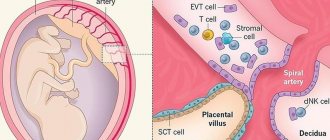Types of premature placental abruption
Premature placental abruption is classified according to severity.
- Mild degree is characterized by premature detachment of a small fragment of the placenta. At the same time, the general condition of the pregnant woman practically does not change. An ultrasound examination may show the presence of a retroplacental hematoma, but if there is slight discharge from the genital organs, it will not be present. After birth, a small clot forms on the placenta.
- With moderate severity, premature placental abruption occurs on a quarter (and sometimes a third) of the surface. Blood is released from the genital tract in clots and in large quantities. Retroplacental hematoma causes abdominal pain, possible hypertonicity of the uterus, as well as its soreness and asymmetry. The mother develops symptoms of painful and hemorrhagic shock. The fetus can die from hypoxia if premature birth is not caused.
- The severe form is characterized by detachment of half the surface of the placenta. External bleeding is preceded by internal bleeding, the woman feels severe pain in the abdomen. Examination of the uterus reveals its asymmetry and tension. Symptoms of acute hypoxia are obvious, and the risk of fetal death is high.
Another common classification is based on the form of placental abruption:
- marginal (peripheral) detachment - accompanied by bleeding;
- central detachment - accompanied by the accumulation of blood between the wall of the uterus and the placenta, as well as a concomitant deterioration in the condition of the pregnant woman;
- combined detachment - combining the symptoms of the previous two.
In addition, premature placental abruption can be progressive or non-progressive, depending on whether the area of placental separation from the uterine wall increases over time.
Causes of premature placental abruption
A disorder such as premature placental abruption can have a variety of causes.
During pregnancy, risk factors may include:
- late toxicosis (gestosis);
- nephropathy of pregnancy;
- vascular extragenital pathology;
- autoimmune conditions;
- inflammation of blood vessels of infectious-allergic origin;
- allergic reactions to blood transfusions;
- endocrine diseases;
- genetic bleeding disorders;
- tendency to thrombosis;
- instability of blood pressure;
- kidney diseases;
- Rh conflict between mother and fetus;
- placental insufficiency;
- location of the placenta in the projection of the myomatous node.
During childbirth, the causes of premature placental abruption can be such phenomena as:
- the birth of the first fetus during multiple pregnancy;
- excessive stimulation of the uterus;
- discoordination of uterine contractions;
- late rupture of membranes;
- short umbilical cord;
- polyhydramnios and rupture of amniotic fluid;
- post-term pregnancy;
- large fruit.
In addition, premature placental abruption can be triggered by mechanical stress:
- fall of a pregnant woman;
- blow to the stomach;
- careless actions of doctors;
- external obstetric rotation of the fetus.
Bad habits of the mother can also complicate the situation.
Comments (2)
- Christina June 27, 2013 00:51
I read about the causes of placental abruption, and among them I did not find the reason why abruption occurs because of cats! During my pregnancy, the gynecologist asked me if I had a cat (I had a cat at that time), after my affirmative answer, she strongly recommended that I give the cat into good hands, otherwise placental abruption might occur! Of course I did so, the child is more important! Can contact with a cat really cause placental abruption? - Alyona 09 July 2013 09:14
Christina, have you been tested for toxoplasmosis? Cats carry this disease and it is transmitted to humans. As my gynecologist explained to me, if the mother already has antibodies to toxoplasma before or during pregnancy, then the child is not in danger, but if there is a cat at home and no antibodies to toxoplasma are detected, then it is better to place the animal in other hands. Very useful article.
Symptoms of premature placental abruption
For a complication such as premature placental abruption, symptoms vary in severity. However, the most common ones are:
- bleeding;
- hypertonicity of the uterus;
- abdominal pain;
- threat of fetal hypoxia.
Bleeding should be discussed separately. It can be internal or external, depending on the degree and shape of the detachment.
- Mild marginal detachment causes slight bleeding from the genital tract.
- In more severe degrees, marginal detachment is accompanied by heavy bleeding. A pregnant woman has to change a pad or tampon about once an hour.
- Central detachment does not entail visible bleeding, in other words, it is internal. Blood permeates the uterine wall and forms a retroplacental hematoma.
You need to pay attention to one more important detail - the color of the blood released. If the blood is bright red, it means it comes from the wall of the uterus, and if it is dark, then it comes from a hematoma.
Hypertonicity of the uterus and pain syndrome increase in parallel. Examination of the uterus reveals:
- tension;
- pain on palpation;
- asymmetry;
- increase in size;
- protrusion of a retroplacental hematoma on the lateral or anterior wall.
The pain is caused by stretching of the serous membrane of the uterus and is more pronounced with central detachment.
In addition, a woman may experience the following symptoms of premature placental abruption:
- backache;
- increased diastolic pressure;
- tachycardia;
- dizziness;
- pale skin;
- general weakness.
The fetus also reacts in its own way to premature placental abruption. In some cases, his heartbeat slows down (less than 120 beats per minute), in others, on the contrary, it speeds up (more than 160 beats per minute).
A state of hypoxia occurs when a third of the surface of the placenta is detached. If the abruption is non-progressive, the baby can be saved if the placenta does not have functional or morphological defects. If the area of placental abruption exceeds a third of the surface, then in most cases the fetus dies.
Publications in the media
Premature placental abruption is the separation of a normally located placenta from the wall of the uterus before the baby is born. The main symptom is bleeding (intrauterine, external or combined) • External bleeding occurs when the peripheral part of the placenta separates. Blood flows through the cervix; the uterus is tense and painful. The fetus is initially viable, then fetal death occurs, coagulopathy occurs (severe in 30% of cases) • Intrauterine bleeding. The uterus is tense and painful; parts of the fetus are not palpable. Diagnosed when a retroplacental hematoma is detected by ultrasound or after the birth of a viable or dead fetus. Blood accumulates between the placenta and uterus; the periphery of the placenta remains attached to the uterus. DIC syndrome is always present.
Statistical data • Frequency of occurrence - 0.5% of all pregnancies •• 56.6% of cases occur during pregnancy •• 43.4% - during periods of dilatation and expulsion • 15% - in the presence of a single placental abruption in history, 20% - with a history of placental abruption more than 1 time. Etiology and pathogenesis • The most common etiological factors •• Toxicosis of the second half of pregnancy (45% of cases occur against the background of prolonged sluggish gestosis) •• Essential arterial hypertension •• Kidney diseases accompanied by arterial hypertension •• Acute infectious diseases • Less common etiological factors •• Trauma as a result of a blow to the abdomen, a fall, external obstetric rotation of the fetus, amniocentesis •• Rapid change in the volume of the uterus after the rupture of amniotic fluid with polyhydramnios or twins •• Chronic urogenital infections •• APS • Risk factors •• Smoking (especially more than 1 pack of cigarettes per day) •• A large number of births in history •• Alcohol abuse, drugs •• Short umbilical cord •• Arterial hypertension due to pregnancy •• History of placental abruption •• Combination of arterial hypertension and 3 (or more) births in history •• Premature birth amniotic fluid •• The pregnant woman is over 35 years old.
An important role in the pathogenesis is assigned to the pathology of the placental vessels (decreased elasticity and increased fragility of the terminal sections of the vessels and septa of the intervillous spaces in the area of placental attachment). The main links in the pathogenesis of placental abruption are spontaneous rupture of blood vessels, the inability of the uterus to effectively contract, the absence of compression of blood vessels with the occurrence of bleeding or the formation of a retroplacental hematoma. Changes in pressure in the vessels of the uterus, fluctuations in the pressure of amniotic fluid and other minor mechanical loads can provoke rupture of pathologically altered vessels.
Classification by severity The degree of placental abruption (mild, moderate, severe) is determined based on the condition of the pregnant woman and the fetus • Mild: placental bleeding <100 ml; <25% of placenta detaches; discomfort in the lower abdomen; incomplete relaxation of the uterus; prolongation of blood clotting time; hypofibrinogenemia, fetal distress • Moderate: placental bleeding 100–500 ml; 25–50% of the placenta is exfoliated; prolonged abdominal pain; continuous strong contractions; possible early consumption coagulopathy; fetal distress • Severe: placental bleeding >500 ml or occult; >50% of placenta detaches; pain in the abdomen is dagger-like, tearing; the uterus does not relax between contractions; shock, oliguria, consumption coagulopathy; severe fetal distress or death.
Clinical picture The clinical picture varies depending on the type and degree of placental abruption. Detachment of the peripheral part of the placenta with external bleeding is less dangerous than central abruption with hidden bleeding • Vaginal bleeding of varying intensity (with average intensity it is necessary to change one sanitary pad or tampon per hour) in the second half of pregnancy •• Blood loss can be hidden (due to the formation retroplacental hematoma), clinical symptoms may not correspond to the amount of external bleeding (up to shock with moderate bleeding) •• Stagnation of blood in the pelvis during pregnancy can increase blood loss •• Since the blood volume during pregnancy is increased, blood loss may exceed 30% before signs of shock and hypovolemia • Pain in the back and abdomen (even in the absence of myometrial contractions) • Myometrial contractions, the uterus is tense and painful, does not completely relax • Decreased pulse pressure, increased diastolic blood pressure, orthostatic hypotension, tachycardia - the first signs of a decrease in blood volume • Deafness of fetal heart sounds, impossibility or difficulty of palpation of parts of the fetus due to tension of the uterus.
Laboratory tests • Determination of blood group, Rh-relatedness • Coombs test • Complete clinical blood test with platelet count and determination of coagulability • Test for compatibility of a woman’s blood with the donor’s blood (carried out three times) • If there is a suspicion of the development of disseminated intravascular coagulation, it is necessary to remember that the content of fibrin breakdown products increases during pregnancy and therefore is not so informative • Normocytic normochromic anemia against the background of acute bleeding • Increased PT and PTT, fibrinogen content less than 1.0–1.5 g/l; with the development of DIC, the number of platelets decreases sharply • A positive test for AT if isosensitization of Ag Rh0-D has occurred.
Special tests • Kleihauer-Betke test to detect fetal bleeding • Bedside coagulation test with absent or weak blood clotting after 7-10 minutes indicates coagulopathy • Test to determine the fetal origin of blood: mix blood taken from the woman’s vagina with a small amount of tap water (so that hemolysis occurs), centrifuge for several minutes; then the liquid located above the sediment and having a pink color due to the Hb contained in it is mixed with sodium hydroxide (1 ml of NaOH for every 5 ml of liquid) and after 2 minutes the color is assessed - if the liquid contains fetal Hb, its color will remain pink, and Hb of an adult will give a yellow-brown color • Hematological staining of vaginal blood and identification of red blood cells containing nuclei (usually they are of fetal origin) • Determination of the lecithin/sphingomyelin ratio in amniotic fluid, if they are deciding on premature delivery • Ultrasound - detection of retroplacental hematoma, rounding of the edge of the placenta or its thickening. Differential diagnosis • Uterine rupture • Placenta previa • Vasa previa • Pathology of the vagina and cervix, leading to bleeding from them • Neoplasms • Other conditions accompanied by abdominal pain (for example, appendicitis) • Childbirth.
TREATMENT Diet. Eating is prohibited until the condition has stabilized and the need for a cesarean section has been eliminated. Management tactics depend on the condition of the woman and fetus and the degree of placental abruption. Hospitalization required until condition stabilizes • Mild - no need for immediate delivery. If fetal distress or increased bleeding is detected, cesarean section is indicated • If the fetus is immature, tocolytic therapy is prescribed • If the fetus is in distress, urgent delivery (vaginal or cesarean section) is necessary • If the fetus is dead and there is no significant bleeding that is not amenable to blood substitute therapy , give preference to delivery through the natural birth canal. Amniotomy is used to induce labor. Administration of oxytocin is prohibited. If placental abruption progresses, urgent operative delivery is indicated even in the event of fetal death • Oxygen inhalation (given to all) • Constant observation for at least 4 hours to identify signs of fetal injury/death, placental abruption, bleeding from the fetus to the pregnant woman (especially if hospitalization was preceded by injury) • Monitoring vital signs, maintaining Ht above 30%, diuresis more than 30 ml/h • Intravenous administration of crystalloid solutions, installation of central catheters only after exclusion of coagulation disorders • Periodic determination of blood clotting time and partial pressure of arterial gases blood if there is a suspicion of the development of acidosis • Positioning the pregnant woman on the left side can increase venous return and cardiac output to 30% of the initial volume • It is possible to install an intrauterine catheter to determine the pressure in the uterine cavity (the danger to the fetus increases with increasing pressure) • With severe abruption placenta, if the fetus is alive and viable, urgent delivery is indicated provided the woman’s condition is satisfactory. Amniotomy speeds up labor.
Drug therapy • Intensive intravenous fluids (0.9% sodium chloride solution or Ringer's solution) • Tocolytics (magnesium sulfate) can be used for small uncomplicated detachment • Rh0-(anti-D)-Ig if the woman's blood is Rh -negative with a positive Kleihauer-Betke test (300 μg of Rh0-[anti-D]-Ig for every 15 ml of fetal red blood cells entering the woman’s bloodstream). If the Kleihauer-Betke test becomes positive again, re-administration of Rh0-(anti-D)-Ig (same calculation) • Transfusion of fresh frozen plasma and platelets for coagulopathy, if indicated - cryoprecipitate and fibrinogen • Transfusion of whole donor blood and frozen red blood cells according indications. Complications • Hemorrhagic shock can develop as a result of both hidden and external blood loss • Consumptive coagulopathy (DIC) - 30% of cases of severe placental abruption, accompanied by fetal death • AKI occurs due to spasm of the renal vessels as a result of massive bleeding and hypovolemia. In severe cases, the development of acute tubular necrosis is possible • Cuveler's symptom complex (Cuveler's uterus) is associated with extensive saturation of the myometrium with blood and its entry under the serous membrane of the uterus. Although in some clinics Kuveler's symptom complex is not considered an indication for hysterectomy, the Russian school of obstetricians and gynecologists recommends extirpation in such cases, and in the presence of small areas of imbibition, limiting it to supravaginal amputation of the uterus • Amniotic fluid embolism (occurs rarely) may cause disseminated intravascular coagulation and severe organ dysfunction breathing.
Course and prognosis • Fetal mortality 0.5–1%, perinatal mortality 30–50% • With trauma and placental abruption, maternal mortality 1%, fetal mortality 30–70% • Labor is usually rapid, but often with weakness of labor.
ICD-10 • O45 Premature placental abruption [abruptio placentae]
Diagnosis of premature placental abruption
The diagnosis of “premature abruption of a normally located placenta” is made based on the results of:
- interviewing the patient for complaints;
- general examination of the woman;
- obstetric and gynecological examination;
- ultrasound diagnostics of the condition of the uterus and fetus;
- cardiotocography;
- laboratory research.
During a gynecological examination, the doctor pays attention to the cervix and external os. When the amniotic sac is opened, the amniotic fluid may contain bloody impurities due to premature placental abruption.
Ultrasound shows:
- where is the retroplacental hematoma located?
- what are its dimensions and structure;
- what is the area of placental abruption.
We must not lose sight of the fact that a mild form of marginal detachment cannot be detected using ultrasound.
Cardiotocography allows you to objectively assess the condition of the fetus based on the dynamics of its cardiovascular system. Another important test to clarify the child’s condition is the Kleihauer-Betke test, which determines whether he is bleeding.
To determine whether the blood is being released from the mother or the baby, a sample is mixed with tap water and sodium hydroxide. If the blood belongs to the fetus, the mixture will remain pink; if not, it will change color to yellowish-brown.
Treatment of premature placental abruption
Premature placental abruption requires immediate hospitalization of the pregnant woman. The goal of treatment is to stabilize the patient's condition, which means stopping bleeding and maintaining fetal viability.
If the degree of detachment is mild, delivery should not be accelerated, but the woman needs close medical supervision. The main task in this case is to identify the causes of premature abruption of a normally located placenta and eliminate them. In addition, a number of related problems need to be solved:
- from the hematopoietic system - dissolve blood clots;
- from the cardiovascular system - normalize blood pressure;
- from the reproductive system - relieve muscle tension of the uterus.
The condition of the fetus must be continuously monitored. In general, with a mild degree of placental abruption, a wait-and-see approach is followed.
In more severe forms of this disorder, as well as in the case of progressive detachment, induction of labor or cesarean section is indicated.
The average severity of detachment allows delivery through the natural birth canal. To do this, the following conditions must be met:
- cervical maturity;
- proportionality of the fetal head and maternal pelvis;
- cephalic presentation of the child;
- sufficient intensity of labor.
The doctor’s actions include the following procedures:
- mothers receive epidural anesthesia;
- a catheter is inserted into the mother’s central vein for timely infusion therapy;
- artificial rupture of the membranes is performed in order to reduce the intensity of bleeding and speed up the birth process;
- Uterine contractions are stimulated with oxytocin.
The entire process must be carried out under the control of the fetal heartbeat, contractile activity of the uterus and maternal hemodynamics.
If there is no possibility of a natural birth, or the mother’s condition is assessed as serious, it is recommended to perform a caesarean section.
In the event of intrauterine fetal death, labor must be induced immediately.
Sometimes, to save the patient's life, it is necessary to surgically remove the uterus. This is done when the uterine wall becomes saturated with blood (this phenomenon is called Couveler’s uterus). It is possible to save an organ if a method of ligating the vessels feeding it is available.
Management of pregnancy and childbirth during PONRP
Pregnancy management depends on the following clinical symptoms:
- Amount of bleeding
. - Gestational age
. - General condition of the woman and child
. - The state of the hemostatic system
(a set of mechanisms that maintain the liquid state of the blood).
If the pregnancy is less than 34 weeks, if the condition of the woman and the fetus remains satisfactory, there are no pronounced symptoms (bleeding, anemia), further continuation of pregnancy is possible. A woman should only stay in a hospital setting under constant medical supervision (daily CTG monitoring, regular Doppler testing, ultrasound).
Conservative treatment for PONRP
:
- Strict bed rest
. - Multivitamin complex
. - Antispasmodics to relieve uterine tone
(Papaverine). - Iron preparations for the prevention or treatment of anemia
(Sorbifer). - Antiplatelet agents
(drugs that reduce the ability of blood to form blood clots). - Drugs that improve uteroplacental blood flow
(Actovegin). - Transfusion of fresh frozen plasma according to indications
.
Important For moderate to severe placental abruption
Emergency delivery by cesarean section is indicated regardless of the stage of pregnancy. During the operation, the uterus is carefully examined to identify extensive hematomas in its walls (Kuveler's uterus).
When diagnosing hemorrhages in the walls of the uterus, ligation of the internal iliac arteries is carried out; if bleeding continues, despite the measures taken, then extirpation (removal) of the uterus is performed.
Forecast and prevention of premature placental abruption
Prevention of premature placental abruption requires, first of all, the pregnant woman’s attentive attitude towards herself:
- treatment of gynecological diseases as part of pregnancy planning;
- timely referral to an antenatal clinic during pregnancy;
- scheduled visits to an obstetrician-gynecologist during pregnancy;
- avoiding physical and mental overload.
The doctor leading the pregnancy must promptly identify pathologies such as:
- placental insufficiency;
- gestosis;
- arterial hypertension.
As for the prognosis for premature placental abruption, everything depends on the timely provision of qualified assistance to the patient.
Classification
There are several classifications of premature placental abruption:
According to the time of occurrence of PONRP
:
- early stages of pregnancy;
- late dates;
- during childbirth.
By area of placental abruption
:
- complete (detachment of the entire area of the placenta);
- partial (only part of the placenta is exfoliated). Partial detachment can be marginal (the edge of the placenta is separated) and central (accordingly, the central part is exfoliated).
According to the progression of detachment
:
- progressive;
- non-progressive (stopped placental abruption).










